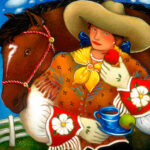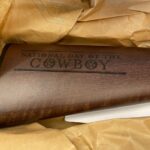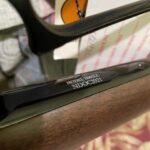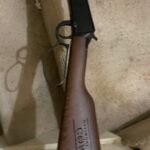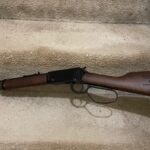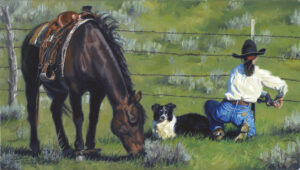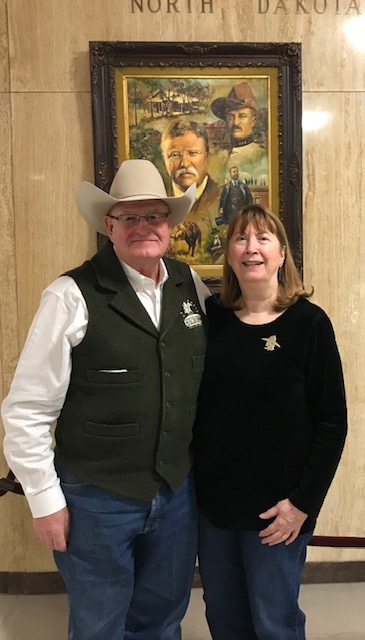Without question, the receiving and reading of nominations for its annual Cowboy Keeper Award is a highlight of every National Day of the Cowboy year. The nominations are always educational and truly awe inspiring. Here are the six incomparable recipients selected by the National Day of the Cowboy’s Board of Directors for its 2019 Cowboy Keeper Awards; Pat and Denny Willis – Arbuckles’ Coffee, Jackson Sundown, Vladimir “Lucky” Lukianenko, Marshall Mitchell, Steve and Marci Shaw – Great American Adventures, and The Stark Museum of Art.
Pat & Denny Willis – Arbuckles’ Coffee
Known to many as “The coffee that won the West,” Arbuckles’ Coffee is a true cowboy tradition kept alive and flourishing by Denny and Pat Willis. Headquartered in Tucson, Arizona, since 1979, Arbuckles’ Coffee began in the post Civil War Era of the 19th Century in Philadelphia, Pennsylvania. Up until the close of that war, coffee beans were sold green and had to be home roasted in an iron skillet over a fire or in a wood stove, making it difficult to achieve consistent results. In 1864, John Arbuckle and his brother Charles, partners in a grocery business, changed all that by patenting a process for roasting and coating coffee beans with an egg and sugar glaze to seal in the flavor and aroma. Their process enabled them to roast a coffee that was of consistently fine quality. They also invented the concept of selling their pre-roasted coffee in patented airtight one pound packages. Their original packaging bore a trademark yellow label with the name, “Arbuckles’” in large red letters across the front, while a flying angel hovered over the words “Ariosa Coffee” stamped in black letters. It was shipped all over the country in wooden crates, one hundred packages to a crate.
The new packaged roasted coffee was an instant success, especially with chuck wagon cooks in the west, who were faced with the task of keeping cowboys supplied with fresh hot coffee out on the range. With the inclusion of John Arbuckle’s original premium item, the peppermint stick, it quickly became the dominant coffee in the west. It was the reward of that peppermint stick that enticed the cowboys to grind the beans for the cook.
Pat and Denny Willis continue to carry on the Arbuckle brothers’ tradition of roasting and distributing world-class coffees, complete with the Flying Angel trademark and a peppermint stick inside each bag. For many of today’s cowboys and chuck wagon cookies, Arbuckles’ remains “the original cowboy coffee.”
Steve and Marcie Shaw – Great American Adventures
Steve and Marcie Shaw grew up on opposite coasts of America, each with a love for the Wild West. Steve relished reruns of 1940’s cowboy flicks and produced his first cowboy film in California, on his dad’s 8mm camera, while Marcie spent her Pennsylvania childhood role playing her favorite cowgirl heroines, such as sharpshooter, Annie Oakley. Twenty years later, they met and married.
Since then, the Shaws have worked to preserve the heritage of the west and share their love of all things western with others. Through their Great American Adventures, they offer historical re-enactment travel, which started with their first ride in 2004, “Custer’s Ride to Glory,” a ride that included Calvary training and staying at the barracks where Custer and his 7th Calvary stayed. That first immersive experience became a hallmark of the rides Steve and Marci offer. Today those rides include Wyatt Earp’s Vendetta Ride, Billy the Kid’s Regulator Ride, Jesse James’ Great Train Robbery, and Wild Bill Hickok’s Last Ride in Deadwood.
On all of these adventures, participants ride on horseback on the original trails through the same territory in which the events took place. Historians along on the ride, offer in-depth details to enrich the learning experience. Period western attire is encouraged, but not required. The Shaw’s hope is that each rider will gain a unique appreciation for the ride and its place in history. The Shaws and their Great American Adventures have earned substantial recognition and numerous awards. In 2012, the State of Arizona, endorsed their “Vendetta Ride” as an Official Arizona Centennial Event. In 2018, Tombstone’s City Historian presented them with the key to the city. Over twenty magazines have written about the significance of their rides, including Cowboy and Indians and Horse and Rider.
“As one who has been on their Vendetta Ride twice, I can assure you, Steve and Marcie Shaw go to great lengths to provide as authentic an old west experience as possible. Through their re-enactment rides, they share their passion for western history and cowboy culture in a way that also works to preserve this heritage.” Brent Slutsky.
Vladimir “Lucky” Lukianenko
The National Day of the Cowboy has had its challenges over the years, including tough times in the summer of 2008, when gas went to $4 a gallon and no one drove to town for weeks, which meant no one dropped in at the National Day of the Cowboy store either. With bills, rent and utilities due, the financial situation grew untenable and the day came when the organization planned to close its store and office and perhaps be forced to abandon the National Day of the Cowboy effort altogether.
That morning, two customers knocked on the door and asked to be let in. Both were wearing cowboy boots, but only one had on a cowboy hat, while the other sported a classy Italian Fedora. The “Fedora” immediately started scoping out everything in the store; the Hatch posters, the photographs, the flags, the caps, the membership display, brochures, and the NDOC buckles. Soon the questions started. “So tell me, what is this National Day of the Cowboy all about? What’s the story on these posters? Why is this cowboy flag hanging here? Who makes these buckles?”
Two hours later, with those many questions satisfied, the key question came, “So how do you pay for all this?” The answer was it was all about end due to a lack of funds. His casual response to that revelation was a simple, “How much do you need to keep it going?” Then, without hesitation, he said, “I will personally see to it that this organization has the money it needs to stay in operation. Don’t give up. This work is important.” He proceeded to stack hats, posters, buckles, pins and flags in a pile on the counter, all of which he purchased on the spot. Next he asked for an address where he could send a donation check. Somewhat in a state of shock, the NDOC thought to ask his name before he went out the door. “My name,” he said so politely, is Vladimir Lukianenko, but YOU may call me Lucky.”
Lucky sent those donations (and more) as promised, and from that day forward, took on the role of Goodwill Ambassador for the National Day of the Cowboy; wrangling donations from friends and folks he met along the trail, urging people to become supporting members, handing out brochures everywhere he traveled, buying NDOC posters and buckles to gift to friends, all the while providing encouragement and sharing his business expertise with the NDOC. Lucky, who is a lifetime buyer and seller of cowboy antiques and collectibles, admitted he’d wanted to be a cowboy all his life, but significant hurdles had stood in his way and now, at last, he was going to be that cowboy, “through the National Day of the Cowboy organization.” Twelve years later, thanks to Lucky’s persistence in knocking on the door, and his pivotal moment of faith in the organization, the National Day of the Cowboy has been able to stay afloat, and to move steadily forward toward establishing a National Day of the Cowboy for all.
Jackson Sundown – Waaya-Tonah-Toesits-Kahn
Legendary Nez Perce warrior and rodeo athlete, Jackson Sundown, has been inducted into the American Indian Athletic Hall of Fame, the National Cowboys of Color Hall of Fame, and the National Cowboy and Western Heritage Hall of Fame. He was the first Native American to win the World Champion Saddle Bronc title at Pendleton, Oregon, yet many have never heard of this impressive cowboy who lived during the time of Chiefs Joseph and Sitting Bull. Jackson Sundown was the name he chose for himself, but his given name was Waaya-Tonah-Toesits-Kahn (Earth Left by the Setting Sun or Blanket of the Sun). Born in Montana in 1863, he was a nephew of the great Chief Joseph. Historical accounts of his life report that he displayed traits of a superior athlete at a young age, including riding his pony from the time he could walk. At age 14, his horse handling skills earned him the privilege of caring for his tribe’s horses and herding them when they moved camp.
On Aug. 9, 1877, Waaya-Tonah-Toesits-Kahn displayed great cunning when his people were ambushed by the U.S. cavalry at Big Hole in Montana territory. Although badly burned, he survived the attack by hiding under a buffalo robe after the cavalry torched his mother’s teepee. Another display of his bravery occurred when the Nez Perce, en route to Sitting Bull’s camp in Canada, stopped to rest near Snake Creek in the Bear Paw Mountains. Unbeknownst to the Nez Perce, Brigadier General Nelson Miles had been ordered to find and intercept them. They made a surprise attack on the Nez Perce and, after a three-day stand-off, war weary Chief Joseph surrendered, declaring he would, “fight no more forever.” Yet again showing his prowess as a warrior, a wounded Sundown escaped. Despite having no blankets or food, he and a small band of survivors made their way to Sitting Bull’s camp in Canada, to live in hiding. Two years later, he secretly rode to Washington, where Joseph and his followers were confined to a small reservation. Joseph warned him not to come to that reservation, so Sundown traveled instead to the Flathead Reservation, where he lived for years, marrying and raising two daughters. In 1910, Sundown rejoined his tribe on the Nez Perce Reservation in Idaho, where he accepted an allotment of land and built a cabin. He remarried and built a home at Jacques Spur, making a living breeding, raising, breaking and selling horses.
At age 49, Sundown began entering rodeo events in Canada and Idaho to earn extra money. He cut a striking figure in a big panama hat, with his long braids tied under his chin by a handkerchief, wearing brightly colored shirts and large wooly angora chaps. His flamboyant look and style made him a crowd favorite. Although twice the age of his competitors, the six-foot tall Indian not only won the bucking championship, but would win cash all-around titles as well. He so dominated the sport that many opponents withdrew upon learning he would be competing.
In 1911, Sundown made the Saddle Bronc finals for the World Championship at the Pendleton Round-Up, an event that ended in controversy and protest. Reports were that Sundown took third after falling from his horse which had run into one of the judges’ horses, but he was not given a re-ride. Western novelist, Rick Steber, chronicled the event in his book, Red White Black, as one that, “forever changed the sport of rodeo and the way the emerging West was to look at itself,” because that championship decision came down to a Native American, an African American, and a white American. In 1915, Sundown again made the Saddle Bronc Finals for the World Championship at Pendleton and when he again placed third, he decided to retire. However, artist Alexander Proctor, who was sculpting Sundown at the time, persuaded the 53-year-old to enter the 1916 Pendleton Round-up and even paid his entrance fee. Sundown’s skill as a horseman and his exceptional rodeo prowess were undeniable the day of the competition. In the final ride Sundown drew an outlaw bronc named Angel. It is said Sundown became one with the horse. As Angel tried one last attempt at throwing him off, Sundown fanned his big hat at the horse. That ride made him a permanent legend in Native American history and Pendleton history. Pitted against him were two great bronc riders half his age, both of whom made epic rides, but Sundown’s ride so far surpassed theirs, he could not be denied. He rode gloriously into the championship amid an ovation never before witnessed, when ten thousand fans cheered themselves hoarse.
Jackson Sundown’s last public appearance was in 1917 with Idaho Governor Moses Alexander. In 1923, Sundown died of pneumonia. He was buried near Jacques Spur, Idaho, not even acknowledged as an American citizen when he died, as Congress did not vote until 1924 to recognize Native Americans as United States citizens. Native American Cowboy Jackson Sundown’s life story is epic. His striking image is recorded for history in photographs and in sculptures of bronze and stone, while his grand adventures are chronicled in museums, documentaries and books.
Stark Museum of Art – Orange, Texas
The Stark Museum of Art opened in November 1978, exhibiting the extraordinary Western American art collection assembled by H.J. Lutcher Stark and his wife Nelda Childers Stark, which encompassed art from John J. Audubon to twentieth century artists of New Mexico. The Museum is committed to preserving, researching, exhibiting, and expanding its collections. The breadth of its cowboy holdings include bronzes by Frederic Remington and Charles M. Russell, illustrations by N.C. Wyeth and Frank Tenney Johnson, carved caricatures by Andy Anderson, and illustrations and stylized figures of pioneers, hunters, and wranglers by William Herbert Dunton. The Museum continues to make acquisitions, including contemporary works by Robert Lougheed, Don Russell, and Thomas Blackshear. It has published research, such as its catalogue The Western Collection 1978, and an in-depth study on The Art and Life of W. Herbert Dunton. The Stark supported the publication by the Buffalo Bill Center of the West, Frederic Remington: A Catalogue Raisonné II, and its online catalogue. The Museum, which has four permanent galleries that feature Western themes and collections, also makes its collections available digitally through its website and with loans to educational exhibitions at other museums. The museum curator, Sarah E. Boehme, has a long history of working to preserve western and cowboy lifestyle.
The programming and culture of the Stark exemplifies the spirit of the cowboy through exhibitions that feature and celebrate the history and mythology of the cowboy. In 2017, the Museum’s major exhibition Branding the American West: Paintings and Films, 1900-1950 detailed the rise of cowboy popularity through film, an important influence in how cowboys have been perceived over the past 100 years. The exhibition and accompanying catalog helped develop new scholarship related to cowboy culture and history. The Stark also mounted an incredible show of the work of photographer Edward S. Curtis in 2018.
In 2018, the Museum focused on two major exhibitions related to the cowboy. The first, Portraits from Cowboys of Color: Photographs by Don Russell centered on black rodeo cowboys. This exhibition highlighted the modern role of black Americans in the rodeo tradition, thus helping expand our vision of the American Cowboy. It featured portraits of contemporary cowboys and cowgirls who ride and rope in Cowboys of Color rodeos. The works reveal a tradition of black cowboy culture often overlooked in history and art. The second exhibition, Cowboy Legends and Life, explored the imagery of the cowboy and cowgirl as icons in American Western art. It presented both the idealization and the working life of men and women of the West, as seen through the Museum’s permanent collections. Both exhibits were enhanced by educational and community based programs.
The Museum has celebrated the National Day of the Cowboy for several years, and as part of its 2018 celebration, hosted a panel discussion Stories from Cowboys of Color: An Afternoon with Don Russell, Cleo Hearn, Bailey’s Prairie Kid, Myrtis Dightman, and Jason Griffin, These important African American Cowboys shared stores of their lives on the rodeo circuit and as working cowboys. This helped underscore the role of Black Americans in cowboy culture and modern practice. The Mayor attended and read the Orange, Texas, National Day of the Cowboy proclamation. Cleo Hearn, founder of the Cowboys of Color Rodeo is himself a 2011 Cowboy Keeper Award recipient.
The Stark Museum continues to strengthen its educational outreach and its commitment to diversity in interpreting the West. Its traveling exhibition Branding the American West: Paintings and Films, 1900-1950 broke new ground. Brigham Young University Museum of Art and the Stark collaborated to exhibit images of the American West as seen through the eyes of the members of the Taos Society of Artists, the artist Maynard Dixon, and films of the era. The accompanying publication served as a catalogue with essays from interdisciplinary perspectives. It received three major awards: the Mountain Plains Museum Association Publication Award for Design in books; an Award of Merit from the American Association for State and Local History; and the 2017 Joan Paterson Kerr Book Award for the best-illustrated book on the history of the American West from the Western History Association.
A recent school outreach mural program focused on United States geography, a history of westward expansion, and an orientation to the exhibition. The Museum also holds an annual juried student art exhibition.
“I have been associated with the history and culture of the American West over the past 43 years, most recently as Executive Director and CEO of the Buffalo Bill Center of the West. I believe the Stark Museum of Art is worthy of receiving the Cowboy Keeper Award and urge the National Day of the Cowboy Organization to bestow their award on the Museum.” Bruce B. Eldredge.
Marshall Mitchell – Arkansas
Singer songwriter, Marshall Mitchell, has performed his “Cowboys for Kids” program for over 60,000 children over the course of his career. His goal as an entertainer is to teach cowboy values such as honesty, integrity and courage, using songs he has written. 2019 saw his 25th year of performing his cowboy program at the annual Stick Horse Rodeo of the Springdale School District in Arkansas. Every first grader in the eighteen elementary schools in the Springdale District has heard his message each year since he began, and there are now parents who reminisce about hearing it when they were first graders themselves. His fans believe that children who have been taught through the joy of Marshall Mitchell’s program will hang onto the lessons they learn for their entire life. Children have so much fun singing and dancing along with him, that they don’t realize they’re being taught important values at the same time. He has performed regionally in seven states, at schools, libraries and special events, in rural and urban settings. In 2010 Mitchell collaborated with Arkansas’ Jennifer Michaels, for her non-profit program, “Clean Water Rangers.” He performed a Clean Water Rangers show for over eight years, which focused on teaching young people to care for the land and water.
Other important aspects of his entertaining include performing classic cowboy songs for adults and seniors at house concerts. Many seniors who are suffering from dementia can be seen responding to his music. Marshall Mitchell and Jennifer Michaels also worked together to secure passage of the National Day of the Cowboy bill in Arkansas, which in 2019 became the 13th state to recognize the 4th Saturday in July as a day to celebrate cowboy culture and pioneer heritage.
The preservation of a heritage depends on those with a willingness to share its history and its culture. In this way, these esteemed recipients have demonstrated a commitment to the protection of this precious heritage. We are grateful for the privilege of recognizing each one with a 2019 Cowboy Keeper Award.. Montana artist, David Graham, a painter of authentic cowboy work and life, donated the image of his working cowgirl painting, “The Fencing Crew,” to be used in this year’s award. The National Day of the Cowboy takes its hat off to these remarkable Cowboy Keeper Award recipients.
Bethany Braley
Executive Director & Publisher
National Day of the Cowboy
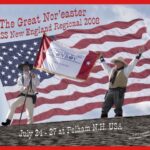
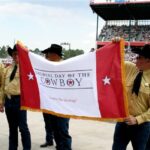

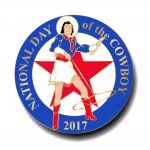

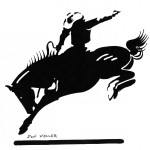

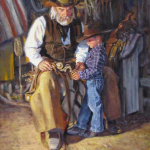

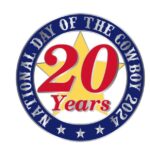
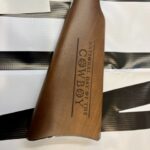

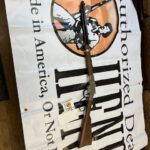
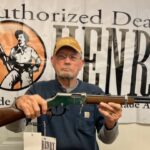 The serial number on the Silver Henry will be NDOC2023. It’s a beautiful, one-of-a-kind rifle since we only raffle one each year. The vice-chairman of our board of directors, Darrell Wyatt, a cowboy who possesses detailed knowledge of the firearms handling and regulations, takes care all of the details of the raffle for us, including the correct shipping to the winning ticket holder.
The serial number on the Silver Henry will be NDOC2023. It’s a beautiful, one-of-a-kind rifle since we only raffle one each year. The vice-chairman of our board of directors, Darrell Wyatt, a cowboy who possesses detailed knowledge of the firearms handling and regulations, takes care all of the details of the raffle for us, including the correct shipping to the winning ticket holder.